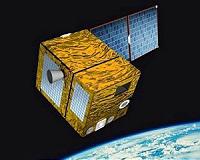 |
Greenbelt MD (SPX) Jan 11, 2010 The latest satellite imagery from NASA's Aqua and Tropical Rainfall Measuring Mission satellites have provided forecasters with signs in clouds and rainfall that Edzani is strengthening in the Southern Indian Ocean. Edzani has become a tropical cyclone as a result of low wind shear and warm ocean temperatures. The Tropical Rainfall Measuring Mission or TRMM satellite's main mission is to monitor rainfall in the global tropics but has also proven very useful for checking on the development of tropical cyclones. TRMM's Precipitation Radar instrument is especially valuable for checking the strength of tropical cyclones located far from land based radar stations. The TRMM satellite passed over Tropical Cyclone Edzani in a remote area of the South Indian Ocean on January 6 at 1502 UTC (10:02 a.m. ET). TRMM rainfall analyses are derived from TRMM's Precipitation Radar (PR) instrument and the TRMM Microwave Imager instrument (TMI). That data is overlaid on an infrared image from TRMM's Visible and Infrared Scanner (VIRS). The Precipitation Radar analysis revealed that the tropical cyclone has strengthened to at least tropical storm strength with very heavy thunderstorms near Edzani's center of circulation. Most of the rainfall in Edzani was moderate, between .78 to 1.57 inches per hour. However, northeast of the center where the highest thunderstorms were located, TRMM indicated heavy rainfall at almost 2 inches per hour. Further development may be likely because TRMM's Precipitation Radar instrument indicates that the powerful thunderstorms near Edzani's center tower to heights above 17 km (~10.6 miles). TRMM is a joint mission between NASA and the Japan Aerospace Exploration Agency (JAXA) designed to monitor and study tropical rainfall. Early this morning, January 7, the Moderate Resolution Spectroradiometer instrument aboard NASA's Aqua satellite captured a visible image of Tropical Cyclone Edzani in the South Indian Ocean. The image showed that circulation around the storm has tightened and an eye is now clearly visible, indicating that the storm has strengthened. Because Edzani continues to be a favorable environment with warm sea surface temperatures over 80 degrees Fahrenheit, and low wind shear, the storm is expected to continue intensifying over the next two days before hitting cooler waters. On January 7 at 1500 UTC (10 a.m. ET), Edzani's center was about 590 nautical miles southeast of Diego Garcia, near 14.6 degrees South and 79.4 degrees East. Edzani is now a Category XX tropical cyclone on the Saffir-Simpson hurricane scale, because it's maximum sustained winds are near 115 mph (185 km/hr) with higher gusts. Edzani is moving southwestward near 5 mph (7 km/hr). Edzani continues to intensify and will keep heading west-southwest before a turn to the south, passing far to the east of Mauritius and La Reunion island. By the weekend, Edzani is expected to run into cooler waters, which will weaken the system.
Share This Article With Planet Earth
Related Links NASA/Goddard Space Flight Center Earth Observation News - Suppiliers, Technology and Application
 The PARASOL Satellite Moving Off The A-Train Track
The PARASOL Satellite Moving Off The A-Train TrackWashington DC (SPX) Jan 05, 2010 After nearly 5 years of concurrent operations with the Afternoon Constellation, known as the "A-Train," the PARASOL satellite is going on another orbit "track." The A-Train includes a number of NASA satellites that orbit the Earth one behind the other on the same track and until this month, PARASOL has been part of that train. PARASOL is an Earth observation mission, managed by the French ... read more |
|
| The content herein, unless otherwise known to be public domain, are Copyright 1995-2009 - SpaceDaily. AFP and UPI Wire Stories are copyright Agence France-Presse and United Press International. ESA Portal Reports are copyright European Space Agency. All NASA sourced material is public domain. Additional copyrights may apply in whole or part to other bona fide parties. Advertising does not imply endorsement,agreement or approval of any opinions, statements or information provided by SpaceDaily on any Web page published or hosted by SpaceDaily. Privacy Statement |